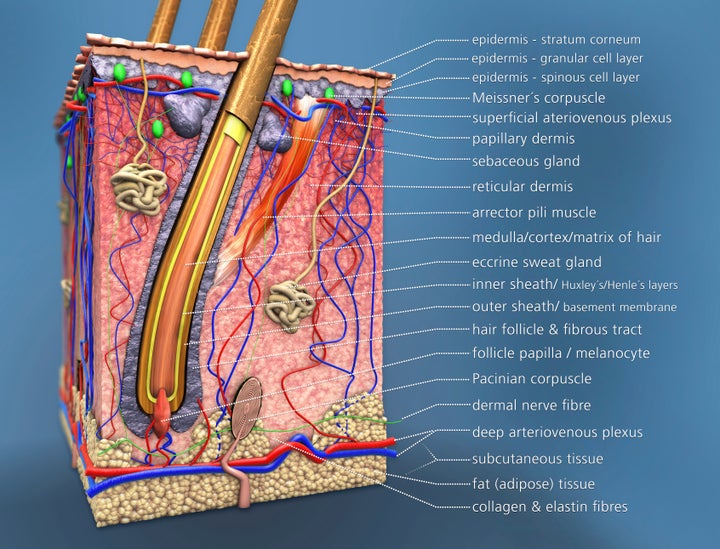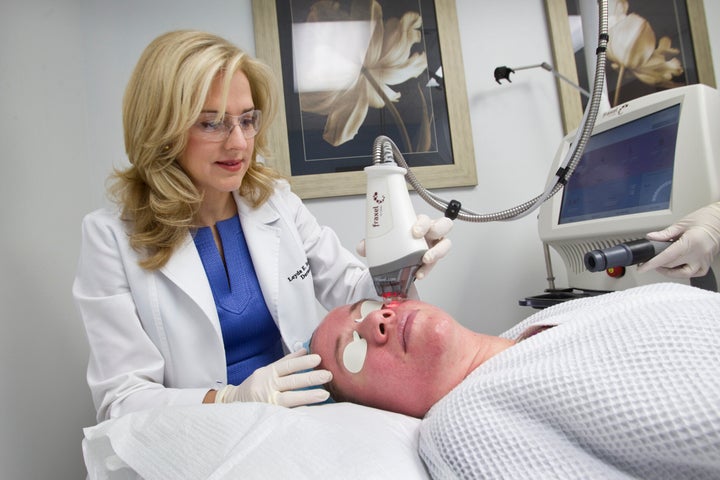Products and procedures claim to minimize the appearance of pores in your skin, but dermatologists explain what works and what doesn’t.
In our pursuit of healthier, smoother skin, we’ve all seen skin care products that promise smaller pores, or even “poreless” skin. But can any serum, face mask or pore strip actually shrink your pores to a size that’s invisible?
As you may have guessed, the notion that topical products can shrink your pores is untrue, according to board-certified dermatologist Tina Alster, creator and co-founder of the skin care company The A Method. And more importantly, you can never eradicate pores completely ― they play a big role in maintaining skin health, and without them we’d be doomed.
“It is a myth that one can have a poreless visage,” Alster told HuffPost, referring to one’s face. “Pores are essential for the normal structure and healthy function of skin.”
Pores are simply the openings of hair follicles, and each pore contains its own sebaceous gland that produces oil, or sebum. Your skin needs sebum for lubrication and protection (though you may experience breakouts if you have an excess of sebum, or dry skin if you have a deficit of sebum).
Thanks to genetics, we have no control over the size of our pores. However, if you want your pores to look smaller, Alster said there are things you can do to slightly minimize their appearance.
Read on for some expert-backed insight into all things pores, detailing everything from effective topical treatments to medical-grade procedures that can guarantee effective results.

Is there anything wrong with having large pores?
While large pores can look pretty scary in a magnifying mirror, they generally pose no health risks at all, board-certified dermatologist Suzanne Friedler told HuffPost.
When people are looking to reduce pore size, most of them do so for cosmetic reasons, as irregular-looking pores can make the skin appear textured, older and damaged, Friedler said. And because big pores are more pronounced, they also create an easy place for makeup to collect, according to board-certified dermatologist Scott Paviol. As a result, makeup applied over the pores can create a cakey appearance, which can be distracting in photos.
While large pores are often a cosmetic nuisance, they can be beneficial in some instances, Paviol told HuffPost.
“Having large pores is not necessarily a bad thing from a health perspective, and may actually be beneficial with age,” he said. “Because larger pores usually create more oil, this can be helpful as we get older and our skin becomes drier.”
How to minimize the appearance of pores with topical treatments
While it may be cosmetically favorable to minimize the appearance of pores, Paviol stressed that we cannot actually change the size of the pore itself.
“Instead, there are lots of things we can do to temporarily refine pores,” he said. “These include using cosmetic products, like sunscreen and foundation, containing dimethicone, a [moisturizing] ingredient that sits on top of the skin and reduces the appearance of pores.”
Some skin care products can also be helpful in minimizing the appearance of pores, Alster said. Consider products that contain acids (particularly glycolic and salicylic acids) or retinol as active ingredients, as they work to unclog pores.
“These ingredients increase skin cell turnover and thus help to unclog pores, which can make them appear smaller,” Alster said.
Last but certainly not least, wearing sun protection daily can also make a tremendous difference. Wearing SPF products consistently helps reduce redness, irritation and discoloration that affect pore appearance, naturopathic doctor Christina Bradshaw said. Not to mention, sun exposure ages skin and contributes to the breakdown of collagen, making skin lose its elasticity, which dilates your pores and makes them appear larger.
“I may sound like a broken record to my patients when it comes to SPF, but it is, hands down, the most important product in anyone’s regimen,” Bradshaw told HuffPost. “It is the best tool we have to prevent breakdown of collagen, one of the main reasons our pores appear larger.”
Medical-grade procedures guarantee more effective results
Topical products may be helpful in cleaning pores and reducing their appearance, but only medical-grade procedures can produce more noticeable results, Friedler said. These include dermatologist-administered microneedling and laser treatments, which usually have no downtime at all — meaning no recovery time is needed.
“The best resource for changing pore size is a dermatologist who can recommend medical-grade treatments, such as lasers,” Friedler said. “Fraxel laser, for example, has no downtime and can improve pigmentation, fine lines and the appearance of pores.”

Similarly, procedures involving the use of botulinum toxin (Botox, Dysport, etc.), can be effective.
“They are helpful in reducing sebum production and pore size through a direct effect on sebaceous and other glands,” Alster said.
If you’re looking for something a little more effective than at-home cleansing but less drastic than an in-office treatment, consider facials, which can be quite effective at keeping the appearance of pores to a minimum. Candace Marino, a Los Angeles-based esthetician, suggested consistent deep cleanings and extractions.
“With regular deep cleanings of the skin and professional extractions, the pores remain cleaner and will appear smaller without the dead cell matter buildup,” she said.
Ever wonder whether something is truly legit? In our series “Convince Me,” we seek objective answers from experts who explain what’s what.
Credit: Source link